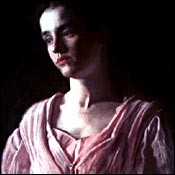
In The Gross Clinic – generally considered the greatest painting in nineteenth-century American art – Thomas Eakins depicted Dr. Samuel David Gross teaching a class in surgery. The surgeon is shown pausing thoughtfully, his face aglow with intelligence, as his assistants slice open the flesh of a patient. A woman covers her eyes, aghast, but otherwise the atmosphere in the operating room is one of luminous scrutiny. In his bloody hand, the great man holds his scalpel as a writer might hold his pen. Or a painter his brush, for there is no question that Eakins – who painted The Gross Clinic as a fairly young artist – identified with Gross’s achievement. Eakins (1844–1916) regarded himself as a surgeon-artist who would use his brush (and camera) to expose the sickly illusions of art during the Victorian era and confront, without flinching, the truths of the flesh. Rather than clothing the naked body in the ideals of “the nude,” he would insist upon the reality of the bare body. Instead of flattering his sitters, he would reveal their inner truths. Even in his famous pictures of rowers on a river, he refused to succumb to the picturesque: The oars and the sculls carve through nature’s flux with scalpel-like precision.
Over the years, the legendary stories about his life – Eakins rattled teacups in Philadelphia by exposing a male model before female students – have only strengthened this reputation for bracing realism. And yet, in the retrospective that opens this week at the Metropolitan Museum of Art, Eakins seems a more subtle, contradictory figure than his reputation for scientific clarity can suggest. Organized by the Philadelphia Museum of Art (H. Barbara Weinberg and Jeff L. Rosenheim are the curatorial shepherds at the Met), Thomas Eakins includes about 150 works, 60 photographs among them. The curators interpolate the photographs amid the paintings, emphasizing that they were a working part of Eakins’s sensibility: Although the painter used photography as a mechanical aid, it is also clear that these photographs became more than a tool to him. Those he took of naked figures, notably men, were not just frank illustrations of the facts but steeped in desire and ambiguity.
Eakins seemed to dramatize nakedness, as many stories about him attest. It may have symbolized for him an Edenic liberation from constraint. (In one photograph, he presented himself without clothes carrying a supine and naked woman in his arms.) Moreover, he was attracted to the “idealism” of manly young bodies, not to the “realism” of aging flesh. Yet there was usually something equivocal in his photographs. It was not just a matter of whether they were sensual or homoerotic. More important, the metaphysical space in Eakins’s art between longing and detachment, analysis and passion, was shadowy and evocatively ill-defined. His joy in the natural body rarely made its way into his major paintings, perhaps because the subject was so personally complex for him. Only in his great Swimming, which shows naked young men at a swimming hole, did he create an American Arcadia. And even there he depicted an older man (himself) swimming toward paradise from the darker edge.
There is such rich melancholy to be found in this surgeon-artist. In Mending the Net, for example, optimism and despair seem perfectly matched. Under a tree that reaches upward with many dead branches – an unmended tree – fishermen look down to repair their damaged nets; in turn, they have as an audience children who look up to them, a man who reads a newspaper, and a gaggle of indifferent geese. In his late portraits, Eakins analyzed people as varied as a dandy with a flowery ear and a cold businessman, but almost always his subjects conveyed a kind of Jamesian regret for the life unlived – a longing for the indefinably more. What should the mended net catch? Where are the sculls going? In one portrait, Eakins presented an actress in a darkened room wearing a dress of lurid red. No doubt the painter, like Dr. Gross, reddened his working hand. But the red of Eakins makes the blood of the operating room seem a simple matter.
Thomas Eakins
At the Metropolitan Museum of Art; 6/18–9/15.